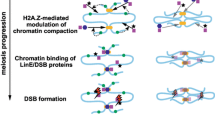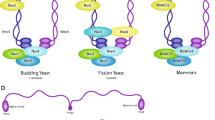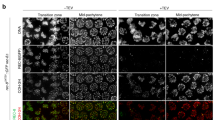Abstract
Meiotic recombination proceeds in biochemical complexes that are physically associated with underlying chromosome structural axes. In this study, we discuss the organizational basis for these axes, the timing and nature of recombinosome/axis organization with respect to the prophase program of DNA and to structural changes, and the possible significance of axis organization. Furthermore, we discuss implications and extensions of our recently proposed mechanical model for chiasma formation. Finally, we give a broader consideration to past and present models for the role of the synaptonemal complex.








Similar content being viewed by others
Notes
It has been proposed that the relationship of DNA events to cytological stages might be different in Drosophila from that described above as the general case. Specifically, it has been suggested that DSBs occur after SC formation (McKim et al. 2002). The primary direct evidence for this view is that gamma-H2AX foci, which mark the sites of both mitotic and meiotic DSBs, can be observed only at pachytene. However, this finding would imply only that SCs form very rapidly after DSB formation, e.g., with little or no “bridge stage.” Alternatively, gamma-H2AX foci have recently been reported also to occur during the pachytene stage in grasshopper (Viera et al. 2004) as a second wave, separate from the late leptotene wave. This raises the additional possibility that, for some reason, only the later foci are detected in Drosophila, thus leading to mistiming of DSB formation.
Abbreviations
- L:
-
leptotene
- Z:
-
zygotene
- P:
-
pachytene
- EP:
-
early pachytene
- MP:
-
middle pachytene
- LP:
-
late pachytene
References
Alani E, Padmore R, Kleckner N (1990) Analysis of wild type and rad50 mutants of yeast suggests an intimate relationship between meiotic chromosome synapsis and recombination. Cell 61:419–436
Albini SM, Jones GH (1987) Synaptonemal complex spreading in Allium cepa and A. fistulosum. I. The initiation and sequence of pairing. Chromosoma 95:324–338
Allers T, Lichten M (2001) Differential timing and control of noncrossover and crossover recombination during meiosis. Cell 106:47–57
Anderson LK, Royer SM, Page SL, McKim KS, Lai A, Lilly MA, Hawley RS (2005) Juxtaposition of C(2)M and the transverse filament protein C(3)G within the central region of Drosophila synaptonemal complex. Proc Natl Acad Sci U S A 102:4482–4487
Bannister LA, Reinholdt LG, Munroe RJ, Schimenti JC (2004) Positional cloning and characterization of mouse mei8, a disrupted allelle of the meiotic cohesin Rec8. Genesis 40:184–194
Barlow AL, Hulten MA (1998) Crossing over analysis at pachytene in man. Eur J Hum Genet 6:350–358
Bennett MD (1977) The time and duration of meiosis. Philos Trans R Soc Lond B 277:201–226
Bhatt AM, Lister C, Page T, Fransz P, Findlay K, Jones GH, Dickinson HG, Dean C (1999) The DIF1 gene of Arabidopsis is required for meiotic chromosome segregation and belongs to the REC8/RAD21 cohesin gene family. Plant J 19:463–472
Bishop DK, Zickler D (2004) Early decision; meiotic crossover interference prior to stable strand exchange and synapsis. Cell 117:9–15
Bishop DK, Park D, Xu L, Kleckner N (1992) DMC1: a meiosis-specific yeast homolog of bacterial recA required for meiotic recombination, synaptonemal complex formation and cell cycle progression. Cell 69:439–456
Blat Y, Protacio R, Hunter N, Kleckner N (2002) Physical and functional interactions among basic chromosome organizational features govern early steps of meiotic chiasma formation. Cell 111:791–802
Börner GV, Kleckner N, Hunter N (2004) Crossover/noncrossover differentiation, synaptonemal complex formation and regulatory surveillance at the leptotene/zygotene transition of meiosis. Cell 117:29–45
Carpenter AT (1975) Electron microscopy of meiosis in Drosophila melanogaster females: II. The recombination nodule—a recombination-associated structure at pachytene? Proc Natl Acad Sci U S A 72:3186–3189
Carpenter AT (1981) EM autoradiographic evidence that DNA synthesis occurs at recombination nodules during meiosis in Drosophila melanogaster females. Chromosoma 83:59–80
Carpenter ATC (1987) Gene conversion, recombination nodules, and the initiation of meiotic synapsis. BioEssays 6:232–236
Clyne RK, Katis VL, Jessop L, Benjamin KR, Herskowitz I, Lichten M, Nasmyth K (2003) Polo-like kinase Cdc5 promotes chiasmata formation and cosegregation of sister centromeres at meiosis I. Nat Cell Biol 5:480–485
Copenhaver GP, Housworth EA, Stahl FW (2002) Crossover interference in Arabidopsis. Genetics 160:1631–1639
Dawe RK, Sedat JW, Agard DA, Cande WZ (1994) Meiotic chromosome pairing in maize is associated with a novel chromatin organization. Cell 76:901–912
de Vries FA, de Boer E, van den Bosch M, Baarends WM, Ooms M, Yuan L, Liu JG, van Zeeland AA, Heyting C, Pastink A (2005) Mouse Sycp1 functions in synaptonemal complex assembly, meiotic recombination, and XY body formation. Genes Dev 19:1376–1389
Dresser ME, Moses MJ (1980) Synaptonemal complex karyotyping in spermatocytes of the Chinese hamster (Cricetulus griseus). IV. Light and electron microscopy of synapsis and nucleolar development by silver staining. Chromosoma 76:1–22
Egel R (1995) The synaptonemal complex and the distribution of meiotic recombination events. Trends Genet 11:206–208
Egel-Mitani M, Olson LW, Egel R (1982) Meiosis in Aspergillus nidulans: another example for lacking synaptonemal complexes in the absence of crossover interference. Hereditas 97:179–187
Eijpe M, Offenberg H, Jessberger R, Revenkova E, Heyting C (2003) Meiotic cohesin REC8 marks the axial elements of rat synaptonemal complexes before cohesins SMC1beta and SMC3. J Cell Biol 160:657–670
Ellermeier C, Smith GR (2005) Cohesins are required for meiotic DNA breakage and recombination in Schizosaccharomyces pombe. Proc Natl Acad Sci U S A 102:10952–10957
Franklin AE, McElver J, Sunjevaric I, Rothstein R, Bowen B, Cande WZ (1999) Three-dimensional microscopy of the Rad51 recombination protein during meiotic prophase. Plant Cell 11:809–824
Fung JC, Rockmill B, Odell M, Roeder GS (2004) Imposition of crossover interference through the nonrandom distribution of synapsis initiation complexes. Cell 116:795–802
Gilbert N, Boyle S, Fiegler H, Woodfine K, Carter NP, Bickmore WA (2004) Chromatin architecture of the human genome: gene-rich domains are enriched in open chromatin fibers. Cell 118:555–566
Gimenez-Abian JF, Clarke DJ, Mullinger AM, Downes CS, Johnson RT (1995) A postprophase topoisomerase II-dependent chromatid core separation step in the formation of metaphase chromosomes. J Cell Biol 131:7–17
Glynn EF, Megee PC, Yu HG, Mistrot C, Unal E, Koshland DE, DeRisi JL, Gerton JL (2004) Genome-wide mapping of the cohesin complex in the yeast Saccharomyces cerevisiae. PLoS Biol 2:E259
Guillon H, Baudat F, Grey C, Liskay RM, de Massy B (2005) Crossover and noncrossover pathways in mouse meiosis. Mol Cell 20:563–573
Heyting C (2005) Meiotic transverse filament proteins: essential for crossing over. Transgenic Res 14:547–550
Higgins JD, Sanchez-Moran E, Armstrong SJ, Jones GH, Franklin FC (2005) The Arabidopsis synaptonemal complex protein ZYP1 is required for chromosome synapsis and normal fidelity of crossing over. Genes Dev 19:2488–2500
Hollingsworth NM, Goetsch L, Byers B (1990) The HOP1 gene encodes a meiosis-specific component of yeast chromosomes. Cell 61:73–84
Hunter N, Kleckner N (2001) The single-end invasion: an asymmetric intermediate at the double-strand break to double-Holliday junction transition of meiotic recombination. Cell 106:59–70
Hunter N, Chambers SR, Louis EJ, Borts RH (1996) The mismatch repair system contributes to meiotic sterility in an interspecific yeast hybrid. EMBO J 15:1726–1733
Keeney S (2001) Mechanism and control of meiotic recombination initiation. Curr Top Dev Biol 52:1–53
King JS, Mortimer RK (1990) A polymerization model of chiasma interference and corresponding computer simulation. Genetics 126:1127–1138
Kleckner N (1996) Meiosis: how could it work? Proc Natl Acad Sci U S A 93:8167–8174
Kleckner N, Padmore R, Bishop DK (1991) Meiotic chromosome metabolism: one view. Cold Spring Harb Symp Quant Biol 56:729–743
Kleckner N, Storlazzi A, Zickler D (2003) Coordinate variation in meiotic pachytene SC length and total crossover/chiasma frequency under conditions of constant DNA length. Trends Genet 19:623–628
Kleckner N, Zickler D, Jones, GH, Henle J, Dekker J, Hutchinson J (2004) A mechanical basis for chromosome function. Proc Natl Acad Sci U S A 101:12592–12597
Klein F, Mahr P, Galova M, Buonomo SB, Michaelis C, Nairz K, Nasmyth K (1999) A central role for cohesins in sister chromatid cohesion, formation of axial elements, and recombination during yeast meiosis. Cell 98:91–103
Lande R, Stahl FW (1993) Chiasma interference and the distribution of exchanges in Drosophila melanogaster. Cold Spring Harb Symp Quant Biol 58:543–552
Lipkin SM, Moens PB, Wang V, Lenzi M, Shanmugarajah D, Gilgeous A, Thomas J, Cheng J, Touchman JW, Green ED, Schwartzberg P, Collins FS, Cohen PE (2002) Meiotic arrest and aneuploidy in MLH3-deficient mice. Nat Genet 31:385–390
MacQueen AJ, Colaiacovo MP, McDonald K, Villeneuve AM (2002) Synapsis-dependent and -independent mechanisms stabilize homolog pairing during meiotic prophase in C. elegans. Genes Dev 16:2428–2442
Maguire MP (1966) The relationship of crossing over to chromosome synapsis in a short paracentric inversion. Genetics 53:1071–1077
Maguire MP (1972) The temporal sequence of synaptic initiation, crossing over and synaptic completion. Genetics 70:353–370
Maguire MP (1988) Crossover site determination and interference. J Theor Biol 134:565–750
Maguire MP (1995) Is the synaptonemal complex a disjunction machine? J Hered 86:330–340
Manheim EA, McKim KS (2003) The synaptonemal complex component C(2)M regulates meiotic crossing over in Drosophila. Curr Biol 13:276–285
McKim KS, Jang JK, Manheim EA (2002) Meiotic recombination and chromosome segregation in Drosophila females. Annu Rev Genet 36:205–232
Moens PB, Earnshaw WC (1989) Anti-topoisomerase II recognizes meiotic chromosome cores. Chromosoma 98:317–322
Moens PB, Pearlman RE (1988) Chromatin organization at meiosis. BioEssays 9:151–153 Mol Cell Biol 21:5667–5677
Moens PB, Kolas NK, Tarsounas M, Marcon E, Cohen PE, Spyropoulos B (2002) The time course and chromosomal localization of recombination-related proteins at meiosis in the mouse are compatible with models that can resolve the early DNA–DNA interactions without reciprocal recombination. J Cell Sci 115:1611–1622
Molnar M, Doll E, Yamamoto A, Hiraoka Y, Kohli J (2003) Linear element formation and their role in meiotic sister chromatid cohesion and chromosome pairing. J Cell Sci 116:1719–1731
Moses MJ (1969) Structure and function of the synaptonemal complex. Genetics 61(Suppl):41–51
Neale MJ, Pan J, Keeney S (2005) Endonucleolytic processing of covalent protein-linked DNA double-strand breaks. Nature 436:1053–1057
Ortiz R, Echeverria OM, Ubaldo E, Carlos A, Scassellati C, Vazquez-Nin GH (2002) Cytochemical study of the distribution of RNA and DNA in the synaptonemal complex of guinea pig and rat spermatocytes. Eur J Histochem 46:133–142
Padmore R, Cao L, Kleckner N (1991) Temporal comparison of recombination and synaptonemal complex formation during meiosis in S. cerevisiae. Cell 66:1239–1256
Page SL, Hawley RS (2004) The genetics and molecular biology of the synaptonemal complex. Annu Rev Cell Dev Biol 20:525–558
Pawlowski WP, Cande WZ (2005) Coordinating the events of the meiotic prophase. Trends Cell Biol 15(12):674–681
Pelttari J, Hoja MR, Yuan L, Liu JG, Brundell E, Moens P, Santucci-Darmanin S, Jessberger R, Barbero JL, Heyting C, Hoog C (2001) A meiotic chromosomal core consisting of cohesin complex proteins recruits DNA recombination proteins and promotes synapsis in the absence of an axial element in mammalian meiotic cells. Mol Cell Biol 21:5667–5677
Plug AW, Peters AH, Xu Y, Keegan KS, Hoekstra MF, Baltimore D, de Boer P, Ashley T (1997) ATM and RPA in meiotic chromosome synapsis and recombination. Nat Genet 17:457–461
Pukkila PJ, Shannon KB, Skrzynia C (1995) Independent synaptic behavior of sister chromatids in Coprinus cinereus. Can J Bot 73(Suppl 1):S215–S220
Rasmussen SW (1986) Initiation of synapsis and interlocking of chromosomes during zygotene in Bombyx spermatocytes. Carlsberg Res Commun 51:401–432
Revenkova E, Eijpe M, Heyting C, Hodges CA, Hunt PA, Liebe B, Scherthan H, Jessberger R (2004) Cohesin SMC1 beta is required for meiotic chromosome dynamics, sister chromatid cohesion and DNA recombination. Nat Cell Biol 6:555–562
Saitoh Y, Laemmli UK (1994) Metaphase chromosome structure: bands arise from a differential folding path of the highly AT-rich scaffold. Cell 76:609–622
Schimenti J (2005) Synapsis or silence. Nat Genet 37:11–13
Sherman JD, Herickhoff LA, Stack SM (1992) Silver staining two types of meiotic nodules. Genome 35:907–915
Stack SM, Anderson LK (1986) Two dimensional spreads of synaptonemal complexes from solanaceous plants. III. Recombination nodules and crossing over in Lycopersicon esculentum (tomato). Chromosoma 94:253–258
Stern H, Westergaard M, Von Wettstein D (1975) Presynaptic events in meiocytes of Lilium longiflorum and their relation to crossing-over: a preselection hypothesis. Proc Natl Acad Sci U S A 72:961–965
Storlazzi A, Xu L, Cao L, Kleckner N (1995) Crossover and noncrossover recombination during meiosis: timing and pathway relationships. Proc Natl Acad Sci U S A 92:8512–8516
Storlazzi A, Tesse S, Gargano S, James F, Kleckner N, Zickler D (2003) Meiotic double-strand breaks at the interface of chromosome movement, chromosome remodeling, and reductional division. Genes Dev 17:2675–2687
Strick R, Laemmli UK (1995) SARs are cis DNA elements of chromosome dynamics: synthesis of a SAR repressor protein. Cell 83:1137–1148
Sym M, Roeder GS (1994) Crossover interference is abolished in the absence of a synaptonemal complex protein. Cell 79:283–292
Tarsounas M, Morita T, Pearlman RE, Moens PB (1999) RAD51 and DMC1 form mixed complexes associated with mouse meiotic chromosome cores and synaptonemal complexes. J Cell Biol 147:207–220
Tease C, Hulten MA (2004) Inter-sex variation in synaptonemal complex lengths largely determine the different recombination rates in male and female germ cells. Cytogenet Genome Res 107:208–215
Tessé S, Storlazzi A, Kleckner N, Gargano S, Zickler D (2003) Localization and roles of Ski8p in Sordaria macrospora meiosis and delineation of three mechanistically distinct steps of meiotic homolog juxtaposition. Proc Natl Acad Sci U S A 100:12865–12870
Turner JM, Mahadevaiah SK, Fernandez-Capetillo O, Nussenzweig A, Xu X, Deng CX, Burgoyne PS (2005) Silencing of unsynapsed meiotic chromosomes in the mouse. Nat Genet 37:41–47
Unal E, Arbel-Eden A, Sattler U, Shroff R, Lichten M, Haber JE, Koshland D (2004) DNA damage response pathway uses histone modification to assemble a double-strand break-specific cohesin domain. Mol Cell 16:991–1002
van Heemst D, Heyting C (2000) Sister chromatid cohesion and recombination in meiosis. Chromosoma 109:10–26
van Heemst D, James F, Poggeler S, Berteaux-Lecellier V, Zickler D (1999) Spo76p is a conserved chromosome morphogenesis protein that links the mitotic and meiotic programs. Cell 98:261–271
Viera A, Santos JL, Page J, Parra MT, Calvente A, Cifuentes M, Gomez R, Lira R, Suja JA, Rufas JS (2004) DNA double-strand breaks, recombination and synapsis: the timing of meiosis differs in grasshoppers and flies. EMBO Rep 5:385–391
von Wettstein D, Rasmussen SW, Holm PB (1984) The synaptonemal complex in genetic segregation. Annu Rev Genet 18:331–413
Whitby MC (2005) Making crossovers during meiosis. Biochem Soc Trans 33:1451–1455
Xu H, Beasley MD, Warren WD, van der Horst GT, McKay MJ (2005) Absence of mouse REC8 cohesin promotes synapsis of sister chromatids in meiosis. Dev Cell 8:949–961
Yamamoto A, Tsutsumi C, Kojima H, Oiwa K, Hiraoka Y (2001) Dynamic behavior of microtubules during dynein-dependent nuclear migrations of meiotic prophase in fission yeast. Mol Biol Cell 12:3933–3946
Zickler D (1977) Development of the synaptonemal complex and the “recombination nodules” during meiotic prophase in the seven bivalents of the fungus Sordaria macrospora Auersw. Chromosoma 61:289–316
Zickler D, Kleckner N (1999) Meiotic chromosomes: integrating structure and function. Annu Rev Genet 33:603–754
Zickler D, Sage J (1981) Synaptonemal complexes with modified lateral elements in Sordaria humana: development of and relationship to the “recombination nodules.” Chromosoma 84:305–318
Acknowledgements
This work was supported by National Institutes of Health (USA) grants GM25326 and GM44794. The author is grateful for ideas and comments from Denise Zickler, Gareth H. Jones and members of the Kleckner lab, and for manuscript help from Jim Henle.
Author information
Authors and Affiliations
Corresponding author
Additional information
Communicated by R. Benavente
The synaptonemal complex—50 years
Appendix
Appendix
Rights and permissions
About this article
Cite this article
Kleckner, N. Chiasma formation: chromatin/axis interplay and the role(s) of the synaptonemal complex. Chromosoma 115, 175–194 (2006). https://doi.org/10.1007/s00412-006-0055-7
Received:
Revised:
Accepted:
Published:
Issue Date:
DOI: https://doi.org/10.1007/s00412-006-0055-7




